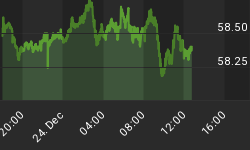Signs Of The Times:
"The decline of the dollar, symbol of US hegemony for the best part of a century, may have become so entrenched that some experts fear it is irreversible."
- The Independent, November 17
"The dollar is in free fall and everyone should be worried about it. The fall in the dollar is not about the fall in the dollar. It's the fall of the American Empire."
- Bloomberg, November 19
US Dollar's Tailspin "Life-threatening" Airbus CEO Says"
- Financial Post, November 23
"The Dollar Index continues to follow our model's path, which is the chart of a severe bear market in an unnamed price-series. Within this, is also the concluding pattern called the "sequential buy". By our reckoning this could conclude within the next two weeks. Providing some guidance is that market sentiment has slipped to the lowest seen since the major low for the DX in late 2004.
"Also building the case for a pending bottom is that our proprietary model is getting close to a capitulation.
"Once the market decides to turn, a week with a higher high than the previous week would start an intermediate recovery in the dollar index.
- Pivotal Events, November 15
The "capitulation" was accomplished on Friday, and advised on Tuesday.
Stock Markets: As part of our theme, for the past few weeks we've mentioned that often severe liquidity crises cleared a number of acute problems in November and the markets recorded a rebound in December. Last week this was accompanied by the mention of a cyclical model that had called for a high close to October 12-14, had also been calling for an important low near the end of November. The net was that December into January could be very volatile, with the market responding to "oversolds" and then being hit by reports of financial disaster.
This seems to be working out, with distinctive change seen over the past few days. The bond spiked up and broke, and the dollar seems to have completed its emotional catharsis.
While we have considered that the contraction would be exacerbated by a strengthening dollar, this step up in the DX is part of the change.
The relief rally could run for a few weeks. Actually, some of it will depend upon how impetuous the bulls become. In looking at yesterday's action with the Nasdaq gaining 3%, and the banks jumping 4%, how long will it take to get the market vulnerable again?
Sector Comment: A couple of weeks ago we noted that the BKX could find support and 85 on the index and at 30 on the RSI. The RSI got to 29 and a few days later on November 21 the BKX set a low of 88. Close enough.
The rebound would likely be technical and should not be considered as predicting sunshine for banks and financials. It can run for a few weeks and we are looking forward to the next exit. It is too bad that the shares of the senior central banks are not publically traded.
Meanwhile, the mining sector has been wonderfully entertained by unusually ambitious boards of directors that have bought the whole story about base metals up forever. After doing a big double top, the SPTMN came down to the level reached in August. However, at 722 it did not reach the intra-day low of 668, but the weekly RSI became rather oversold.
Usually at this time of year we would be establishing a big position on the seasonal low. There is still a lot of potential distress across the board, but some nimble traders could work at some modest positions -- perhaps a little now and more on possible weakness in January.
Credit Spreads: Pressures on the sub-prime became severe into Monday and there has been a bounce in price. This could continue for a few weeks.
Widening of traditional corporate spreads continued for a few days more and can take a few weeks of respite as well.
We can't help but wonder how all those central bank reserve managers have been feeling about being so positive about buying "spread product" last May. Since then, for example, the spread for junk, over treasuries, has widened from 425 bps to 838 bps, and most of the innovative stuff is no bid.
One would think that after their huge embarrassment with the hit in the LTCM collapse that central banks would avoid risk like the plague. But, perhaps they believe that all of their operations (including their own positions) are immune to risk.
The danger to investors is what extreme measures the central banking crowd will impose in attempts to restore their "profitability" and to prove the theories memorized in Market Manipulation 101.
















